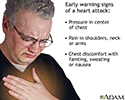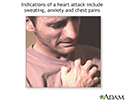Heart attack first aid
First aid - heart attack; First aid - cardiopulmonary arrest; First aid - cardiac arrest
A heart attack is a medical emergency. Call 911 or your local emergency number if you think you or someone else is having a heart attack.
Heart attack
Most heart attacks are caused by a blood clot that blocks one of the coronary arteries. The coronary arteries bring blood and oxygen to the heart. ...

The average person waits 3 hours before seeking help for symptoms of a heart attack. Many heart attack patients die before they reach a hospital. The sooner the person gets to the emergency room, the better the chance of survival. Prompt medical treatment reduces the amount of heart damage.
This article discusses what to do if you think someone may be having a heart attack.
Causes
A heart attack occurs when the blood flow that carries oxygen to the heart is blocked. The heart muscle becomes starved for oxygen and begins to die.
Symptoms
Symptoms of a heart attack can vary from person to person. They may be mild or severe. Women, older adults, and people with diabetes are more likely to have subtle or unusual symptoms.
Symptoms in adults may include:
- Changes in mental status, especially in older adults.
-
Chest pain
that feels like pressure, squeezing, or fullness. The pain is most often in the center of the chest. It may also be felt in the jaw, shoulder, arms, back, and stomach. It can last for more than a few minutes, or come and go.
Chest pain
Chest pain is discomfort or pain that you feel anywhere along the front of your body between your neck and upper abdomen.
 ImageRead Article Now Book Mark Article
ImageRead Article Now Book Mark Article - Cold sweat.
- Lightheadedness.
- Nausea (more common in women).
- Numbness, aching, or tingling in the arm (usually the left arm, but the right arm may be affected alone, or along with the left).
-
Shortness of breath
.
Shortness of breath
Breathing difficulty may involve:Difficult breathingUncomfortable breathingFeeling like you are not getting enough air
 ImageRead Article Now Book Mark Article
ImageRead Article Now Book Mark Article - Weakness or fatigue, especially in older adults and in women.
First Aid
If you think someone is having a heart attack:
- Have the person sit down, rest, and try to keep calm.
- Loosen any tight clothing.
- Ask if the person takes any chest pain medicine, such as nitroglycerin, for a known heart condition, and help them take it.
- If the pain does not go away promptly with rest or within 3 minutes of taking nitroglycerin, call for emergency medical help.
-
If the person is
unconscious
and unresponsive, call 911 (or your local emergency number), then begin
CPR
.
Unconscious
Unconsciousness is when a person is unable to respond to people and activities. Doctors often call this a coma or being in a comatose state. Other c...
 ImageRead Article Now Book Mark Article
ImageRead Article Now Book Mark ArticleCPR
CPR stands for cardiopulmonary resuscitation. It is an emergency lifesaving procedure that is done when someone's breathing or heartbeat has stopped...
Read Article Now Book Mark Article - If an infant or child is unconscious and unresponsive, perform 1 minute of CPR, then call 911.
Do Not
- Do NOT leave the person alone except to call for help, if necessary.
- Do NOT allow the person to deny the symptoms and convince you not to call for emergency help.
- Do NOT wait to see if the symptoms go away.
- Do NOT give the person anything by mouth unless a heart medicine (such as nitroglycerin) has been prescribed.
When to Contact a Medical Professional
Call 911 or your local emergency number immediately if the person:
- Does not respond to you
- Is not breathing
- Has sudden chest pain or other symptoms of a heart attack
Prevention
Adults should take steps to control heart disease risk factors whenever possible.
-
If you smoke, quit. Smoking more than doubles the chance of developing
heart disease
.
Heart disease
Coronary heart disease is a narrowing of the small blood vessels that supply blood and oxygen to the heart. Coronary heart disease (CHD) is also cal...
 ImageRead Article Now Book Mark Article
ImageRead Article Now Book Mark Article -
Keep blood pressure, cholesterol, and
diabetes
in good control and follow your health care provider's orders.
Diabetes
Diabetes is a chronic disease in which the body cannot regulate the amount of sugar in the blood.
 ImageRead Article Now Book Mark Article
ImageRead Article Now Book Mark Article -
Lose weight if
obese
or overweight.
Obese
Nearly 2 out of every 3 adults in the United States are overweight.
 ImageRead Article Now Book Mark Article
ImageRead Article Now Book Mark Article - Get regular exercise to improve heart health. (Talk to your provider before starting any new fitness program.)
- Eat a heart-healthy diet. Limit saturated fats, red meat, and sugars. Increase your intake of chicken, fish, fresh fruits and vegetables, and whole grains. Your provider can help you tailor a diet specific to your needs.
- Limit the amount of alcohol you drink. One drink a day is associated with reducing the rate of heart attacks, but two or more drinks a day can damage the heart and cause other medical problems.
References
Jneid H, Anderson JL, Wright RS, et al. 2012 ACCF/AHA focused update of the guideline for the management of patients with unstable angina/non-ST-elevation myocardial infarction (updating the 2007 guideline and replacing the 2011 focused update): a report of the American College of Cardiology Foundation/American Heart Association Task Force on practice guidelines. J Am Coll Cardiol . 2012;60(7):645-681. PMID: 22809746 www.ncbi.nlm.nih.gov/pubmed/22809746 .
Kurz MC, Mattu A, Brady WJ. Acute coronary syndrome. In: Marx JA, Hockberger RS, Walls RM, et al, eds. Rosen's Emergency Medicine: Concepts and Clinical Practice . 8th ed. Philadelphia, PA: Elsevier Saunders; 2014:chap 78.
Levin GN, Bates ER, Blankenship JC, et al. 2015 ACC/AHA/SCAI focused update on primary percutaneous coronary intervention for patients with ST-elevation myocardial infarction: An update of the 2011 ACCF/AHA/SCAI Guideline for percutaneous coronary intervention and the 2013 ACCF/AHA guideline for the management of ST-elevation myocardial infarction. J Am Coll Cardiol . 2016;67(10):1235-1250. PMID: 26498666 www.ncbi.nlm.nih.gov/pubmed/26498666 .
-
Heart attack symptoms - illustration
Symptoms of a heart attack may widely vary, from the classic "elephant on the chest" feeling of crushing pain, to the nausea and heartburn mistaken for indigestion. In some patients, the symptoms may only be sudden fatigue or an oppressive feeling of impending doom.
Heart attack symptoms
illustration
-
Symptoms of heart attack - illustration
Symptoms of a heart attack can vary widely and can mimic other conditions such as indigestion or heartburn. The important fact to know is to take all heart attack related symptoms seriously and seek medical help as soon as possible.
Symptoms of heart attack
illustration
-
Heart attack symptoms - illustration
Symptoms of a heart attack may widely vary, from the classic "elephant on the chest" feeling of crushing pain, to the nausea and heartburn mistaken for indigestion. In some patients, the symptoms may only be sudden fatigue or an oppressive feeling of impending doom.
Heart attack symptoms
illustration
-
Symptoms of heart attack - illustration
Symptoms of a heart attack can vary widely and can mimic other conditions such as indigestion or heartburn. The important fact to know is to take all heart attack related symptoms seriously and seek medical help as soon as possible.
Symptoms of heart attack
illustration
-
Burns
(Alt. Medicine)
-
Shock
(Alt. Medicine)
-
Anxiety disorders
(In-Depth)
-
Systemic lupus erythematosus
(In-Depth)
-
Epilepsy
(In-Depth)
-
Acute lymphocytic leukemia
(In-Depth)
-
Shingles and chickenpox (Varicella-zoster virus)
(In-Depth)
-
Insomnia
(In-Depth)
-
Travel to developing countries
(In-Depth)
-
Colds and the flu
(In-Depth)
Review Date: 10/2/2016
Reviewed By: Jacob L. Heller, MD, MHA, Emergency Medicine, Virginia Mason Medical Center, Seattle, WA. Also reviewed by David Zieve, MD, MHA, Isla Ogilvie, PhD, and the A.D.A.M. Editorial team.


